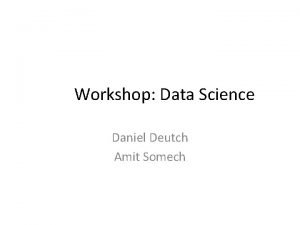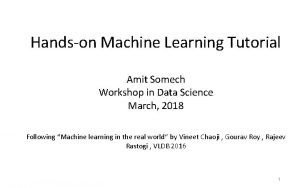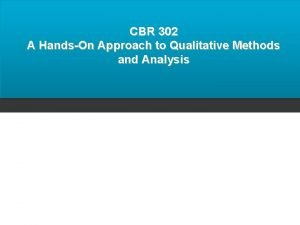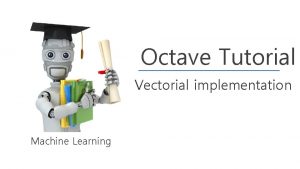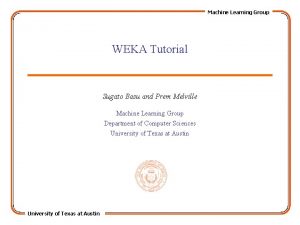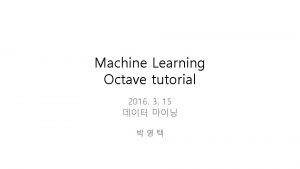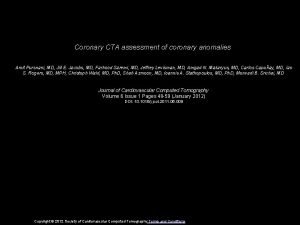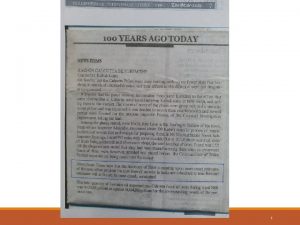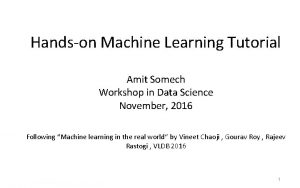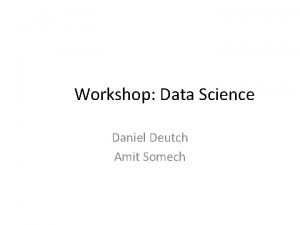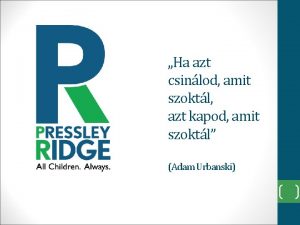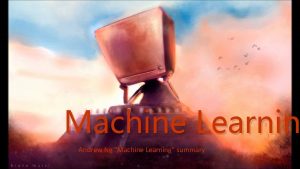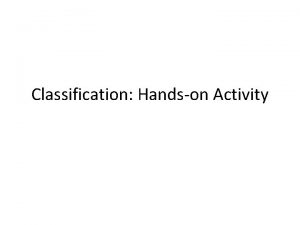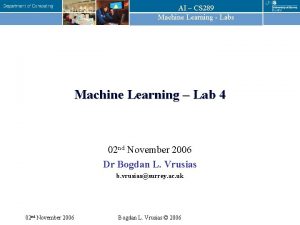Handson Machine Learning Tutorial Amit Somech Workshop in





































- Slides: 37

Hands-on Machine Learning Tutorial Amit Somech Workshop in Data Science March, 2018 Following “Machine learning in the real world” by Vineet Chaoji , Gourav Roy , Rajeev Rastogi , VLDB 2016 1

Things we cover today • Practical introduction to Machine learning • Tools and frameworks • ML project example 2

Things we *don’t* cover today • • We do not teach Machine learning We do not provide all the necessary background We do not teach how to use tools and libraries We can help you to learn by yourself: – schedule meetings with us – be prepare for the milestone meetings throughout the semester. 3

Again, What is Machine Learning? “Machine Learning systems discover hidden patterns in data, and leverage the patterns to make predictions about future data. ” Example Pattern: If a product title contains the words “Jeans” or “Jacket” product belongs to Apparel category 4

Some Examples • SPAM detection – Task: distinguish between SPAM and legitimate email – Evaluation: % of emails correctly classified – Learning Source: hand-labeled emails • Detecting catalog duplicates – Task: distinguish between duplicate and non-duplicate catalog entries – Evaluation: false positive/negative rate based on business criteria – Learning Source: hand-labeled duplicates and non-duplicates • Go learner – Task: playing Go – Evaluation: % of games won in tournament – Learning Source: practice games against itself

Small Exercise • What is the target variable to be predicted, training examples and features for the following ML problems – Forecasting the demand for a product – Classifying products into categories – Detecting fraudulent orders – Predicting the base price of a product – Predicting if a user will click on an ad – Recommending products to customers – Matching products to identify duplicates 6

Machine Learning Problem Definition • Key elements of Prediction Problem – Target variable to be predicted – Training examples – Features in each example (Categorical, Numeric, Text) • Example: Income classification problem – Predict if a person makes more than $50 K Age Education Years of education Marital status Occupation Sex Label 39 Bachelors 16 Single Adm-clerical Male <50 K (-1) 31 Masters 18 Married Engineering Female >=50 K (+1) Numeric Categorical 7

Supervised Learning • Training: Given training examples {(Xi, Yi)} where Xi is the feature vector and Yi the target variable, learn a function F to best fit the training data (i. e. , Yi ≈ F(Xi) for all i) Historical Data (X 1, Y 1) (X 2, Y 2) …. (Xn, Yn) Learning Algorithm Model F • Prediction: Given a new sample X with unknown Y, predict Y using F(X) X Y URL Title/Body Text Feature Extraction Model F E-commerce Site ? Hyperlinks Features/Attributes Target/Label 8

Types of Supervised Learning • Classification: Y is categorical – Examples: • Web page classification as e-Commerce/non e-Commerce (Binary) • Product classification into categories (Multi-class) – Model F: Logistic Regression, Decision Trees, Random Forests, Support Vector Machines, Naïve Bayes, etc. • Regression: Y is numeric (ordinal/real-valued) – Examples: • Base price markup prediction for a product • Forecasting demand for a product – Model F: Linear Regression, Regression Trees, Kernel Regression, etc. 9

Supervised Learning Recap • We want to learn a function F that predicts y for a given x – Need a feature space representation (Categorical, Numeric, Text) – Want a function that generalizes to new (testing) data • Example: Income classification problem – Predict if a person makes more than $50 K Age Education Years of education Marital status Occupation Sex Label 39 Bachelors 16 Single Adm-clerical Male <50 K (-1) 31 Masters 18 Married Engineering Female >=50 K (+1) Numeric Categorical 10

Types of Features Age Education Years of education Marital status Occupation Sex Label 39 Bachelors 16 Single Adm-clerical Male <50 K (-1) 31 Masters 18 Married Engineering Female >=50 K (+1) Numeric Categorical • Categorical/Nominal – Occupation, Marital Status, Prime Subscriber • Numeric – Age, Orders in the last month, Total spend in the last year – Quantity (Integer or Real): Price, Votes – Interval: Dates, Temperature – Ratio: Quarterly growth • Ordinal – Education level, Star rating for a product 11

Other Types of Data • Matrix Data – A design matrix X and label vector y • Text – Customer reviews, product descriptions • Images – Product images, Maps • Set Data – Items purchased together • Sequence Data – Clickstream, Purchase history • Time Series – Audio/Video, Stock prices • Graph/Network – Social Networks, WWW 12

End-to-End Model Building Process Business Problem ML Problem Framing ML Problem + Metrics Data Collection & Integration Dataset Data Preparation & Cleaning Data Summary reports Feature Augment Data Augment High Quality Dataset Data Visualization & Analysis Feature Engineering Feature Vectors + Target Model Training + Parameter Tuning Predictive Model Evaluation Performance Metrics No Meet Business Goals? Yes Model Deployment Predictions 18

Hands-on Session Problem Framing, Data collection & cleaning https: //github. com/TAU-DB/Data. Science-class 19

Tools/Frameworks used • Python – Pandas – Easy to use data analysis tools for Python – Numpy/Scipy – Scientific computation with Python and efficient multi-dimensional container of generic data. – Scikit-learn – A Scipy extension for machine learning. – Seaborn - Python visualization library & provides a high-level interface for drawing attractive statistical graphics. • Based on Matplotlib – A python 2 D plotting library. • Integration with Pandas and Numpy data-structures. • Jupyter notebook: a web-based wrapper for ipython aim for better visualization and code sharing. • Spark – Spark ML Pipeline – Easy to use distributed machine learning library. 20

1. Problem Framing: Income classification problem • ML Task: Predict if a person makes more than $50 K • Data: Age Education Years of education Marital status Occupation Sex Label 39 Bachelors 16 Single Adm-clerical Male <50 K (-1) 31 Masters 18 Married Engineering Female >=50 K (+1) Numeric Categorical 21

2. Data Preparation • Transform data to appropriate input format – CSV format, headers specifying column names and data types – Filter XML/HTML from text • Split data into train and test files – Training data used to learn models – Test data used to evaluate model performance • Randomly shuffle data – Speeds convergence of online training algorithms • Feature scaling (for numeric attributes) – Subtract mean and divide by standard deviation -> zero mean, unit variance – Speeds convergence of gradient-based training algorithms 22

2. Data Cleaning • Missing feature values, outliers can hurt model performance • Strategies for handling missing values, outliers – Introduce new indicator variable to represent missing value – Replace missing numeric values with mean, categorical values with mode – Regression-based imputation for numeric values Age Education Years of education Marital status Occupation Sex Label 39 Bachelors 16 Single Adm-clerical Male 0 31 Masters 18 Married Engineer Female 1 44 Bachelors 16 Accounting Male 0 150 38 Bachelors 14 Married Engineer Female 0 Outlier Mean Missing values Mode 23

Demonstration #2 24

3. Data Visualization & Analysis • Better understanding of data -> Better feature engineering & modeling Types of visualization & analysis • Feature and target summaries – Feature and target data distribution, histograms – Identify outliers in data, detect skew in feature/class distribution • Feature-Target correlation – Correlation measures like mutual information, Pearson’s correlation coefficient – Class distribution conditioned on feature values, scatter plots – Identify features with predictive power, target leakers 25

Demonstration #3 26

Model Building Process Business Problem ML Problem Framing ML Problem + Metrics Data Collection & Integration Dataset Data Preparation & Cleaning Augment Data Summary reports Feature Data Augment High Quality Dataset Data Visualization & Analysis Feature Engineering Feature Vectors + Target Model Training + Parameter Tuning Predictive Model Evaluation Performance Metrics No Meet Busin ess Goals? Yes Model Deployment Predictions 49

4. Feature Engineering • Features are the way that the model “sees” the data. We need to: 1. Construct new features with predictive power from raw data -> boost model performance 2. Transform raw features: – – Non-linear feature transformations for linear models Domain-specific transformations for text etc. Feature selection (drop noisy features) Dimensionality reduction 50

Numeric Value Binning • Introduce non-linearity into linear models • Intuition: Salary isn’t linear with age Age Binned Education Occupation Education Years of Marital. Occupation Age education status 39 39 Bachelors 16 Bin 2 Bachelors 31 31 44 44 62 Masters 18 Bin 2 Masters Bachelors 16 Bin 3 Bachelors 14 62 Bin 4 Binned Age: Bin 1 16 18 16 20 Bachelors 14 40 Bin 2 Sex Single Adm-clerical Male Single Adm. Male clerical Married Engineer Female Married Accounting Male Married Engineer Female 60 Married Bin 3 Engineer Bin 4 Female Label -1 -1 +1 +1 -1 -1 • Binning strategies: equal ranges, equal number of examples, maximize purity measure (e. g. entropy) of each bin 51

Quadratic Features • Derive new non-linear features by combining feature pairs • Example: People with a Masters degree in Business make much more than people with Masters or Business degrees Age. Education of of Marital Education Years Marital Occupation Sex education status Education + Label Occupation Business Male Bachelors_Business -1 Label 39 39 Bachelors 16 16 Single 31 31 Masters 18 18 Married Business Female. Masters_Business +1 44 44 Bachelors 16 16 Married -1 Married Accounting. Male Bachelors_Accounting -1 Quadratic feature over Education and Occupation 62 62 Masters 14 14 Married Engineer Female. Masters_Engineer -1 -1 +1 -1 52

Feature Selection • Often, “Less is More“ – Better generalization behavior (useful to prevent “overfitting”) – More robust parameter estimates with smaller number of nonredundant features • Strategies for selecting features with predictive power – Features that are strongly correlated with target variable • Information gain, mutual information, Chi-square score, Pearson’s correlation coefficient – Features with high correlation with residual of target given other variables • Forward/backward selection, ANOVA analysis – Features with high importance scores (e. g. weights) during model training 55

Demonstration #4 57

Model Building Process Business Problem ML Problem Framing ML Problem + Metrics Data Collection & Integration Dataset Data Preparation & Cleaning Augment Data Summary reports Feature Data Augment High Quality Dataset Data Visualization & Analysis Feature Engineering Feature Vectors + Target Model Training + Parameter Tuning Predictive Model Evaluation Performance Metrics No Meet Busin ess Goals? Yes Model Deployment Predictions 58

Parameter Tuning • Model training algorithms have multiple parameters • Loss function – Squared: regression, classification – Hinge: classification only, more robust to outliers – Logistic: classification only, better for skewed class distributions • Number of passes – More passes -> better fit on training data, but diminishing returns • Regularization – Prevent overfitting by constraining weights to be small • Learning parameters (e. g. decay rate) – Decaying too aggressively -> algorithm never reaches optimum – Decaying too slowly -> algorithm bounces around, never converges to optimum 59

Parameter Tuning Strategies • Optimize one parameter at a time (keeping others fixed at defaults) – May not work too well if strong correlation between parameters • Randomly explore joint parameter configuration space – stop when model performance improvement drops below threshold • Use k-fold cross-validation to evaluate model performance for a given parameter setting – – Randomly split training data into k parts Train models on k training sets, each containing k-1 parts Test each model on remaining part (not used for training) Average k model performance scores 60

Demonstration #5 61

Classification – Evaluation Metrics • • • For each threshold, Confusion matrix for binary classification of +1 vs. -1 Actual +1 Actual -1 Predicted +1 TP FP Predicted -1 FN TN Precision = TP/(TP+FP): How correct are you on the ones you predicted +1? Recall = TP/(TP+FN): What fraction of actual +1’s did you correctly predict ? True Positive Rate (TPR) = Recall False Positive Rate (FPR) = FP/(FP+TN): What fraction of -1’s did you wrongly predict? 63

AUC: Area under ROC curve • Plots TPR vs FPR for different thresholds • Odds of scoring +1 > -1 • Perfect: AUC =1 • Random: AUC =0. 5 True Positive Rate ROC Curve & AUC 90% Operational point: TPR – FPR is maximum False Positive Rate 64

Precision-Recall Curve 1 High Precision High Recall Precision 0. 75 0. 25 0. 5 Recall 0. 75 1 65

Model Building Process Business Problem ML Problem Framing ML Problem + Metrics Data Collection & Integration Dataset Data Preparation & Cleaning Augment Data Summary reports Feature Data Augment High Quality Dataset Data Visualization & Analysis Feature Engineering Feature Vectors + Target Model Training + Parameter Tuning Predictive Model Evaluation Performance Metrics No Meet Busin ess Goals? Yes Model Deployment Predictions 68

Summary: How to get 95+ 1. 2. 3. 4. 5. Consider *each* phase of the project: from formulating the problem, into parameter tuning Explain every decision you make in your documentation. Write clearly and concisely! Submit a beautiful, informative notebook. Add meaningful visualizations. In the work progress: : – The more training examples, the better • Large training sets lead to better generalization to unseen examples – The more features, the better (also, less – is more) • Invest time in feature engineering to construct features with signal – Evaluate model performance on separate test set • Tune model parameters on separate validation set (and not test set) – Select appropriate evaluation metrics • AUC may not always be appropriate, Log-likelihood, Precision@K – Retrain models periodically • Ensure training data distribution is in sync with test data distribution 72

Thank you! 73
 Daniel deutch
Daniel deutch Amit somech
Amit somech This is the religion that god accepts
This is the religion that god accepts Handson may
Handson may Analytical research
Analytical research James handson
James handson James handson
James handson A handson
A handson Handson activities
Handson activities Handson activities
Handson activities Handson session
Handson session Sigmoid function octave
Sigmoid function octave Sugato basu
Sugato basu Octave machine learning
Octave machine learning Concept learning task in machine learning
Concept learning task in machine learning Analytical learning in machine learning
Analytical learning in machine learning Pac learning model in machine learning
Pac learning model in machine learning Pac learning model in machine learning
Pac learning model in machine learning Inductive and analytical learning
Inductive and analytical learning Inductive and analytical learning
Inductive and analytical learning Instance based learning in machine learning
Instance based learning in machine learning Inductive learning machine learning
Inductive learning machine learning First order rule learning in machine learning
First order rule learning in machine learning Eager classification versus lazy classification
Eager classification versus lazy classification Cmu machine learning
Cmu machine learning Cuadro comparativo e-learning m-learning b-learning
Cuadro comparativo e-learning m-learning b-learning Amit pursnani
Amit pursnani Amit dio egizio
Amit dio egizio Amit garg irse
Amit garg irse Amit shah 1800flowers
Amit shah 1800flowers Amit bhan
Amit bhan Amit idg780
Amit idg780 Amit gupta microsoft
Amit gupta microsoft Amit nanavati md
Amit nanavati md Dr gary vitale louisville ky
Dr gary vitale louisville ky Dr amit shah cardiologist
Dr amit shah cardiologist Amit bhandutia
Amit bhandutia Confidential vms
Confidential vms
